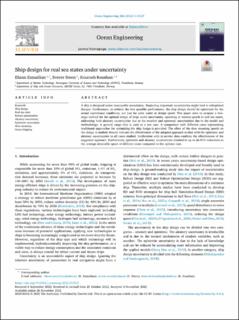| dc.contributor.author | Esmailian, Ehsan | |
| dc.contributor.author | Steen, Sverre | |
| dc.contributor.author | Koushan, Kourosh | |
| dc.date.accessioned | 2023-01-12T11:39:22Z | |
| dc.date.available | 2023-01-12T11:39:22Z | |
| dc.date.created | 2022-09-13T12:52:05Z | |
| dc.date.issued | 2022 | |
| dc.identifier.citation | Ocean Engineering. 2022, 266 (5), . | en_US |
| dc.identifier.issn | 0029-8018 | |
| dc.identifier.uri | https://hdl.handle.net/11250/3042997 | |
| dc.description.abstract | A ship is designed under inescapable uncertainty. Neglecting important uncertainties might lead to suboptimal designs. Furthermore, to achieve the best possible performance, the ship design should be optimized for the actual operational conditions, not just for calm water at design speed. This paper aims to propose a two-stage method for the optimal design of ships under uncertainty, operating at various speeds in real sea states, addressing both aleatory uncertainties due to the weather and epistemic uncertainties due to the model and methodology. A general cargo ship is used as a test case. A comparison with different cases representing traditional approaches for optimizing the ship design is provided. The effect of the slow steaming speeds on the design is studied. Results indicate the effectiveness of the adopted approach to deal with the epistemic and aleatory uncertainties in all cases studied. Verification with in-service data confirms the effectiveness of the suggested approach. Furthermore, epistemic and aleatory uncertainties resulted in up to 26.91% reductions in the average attainable speed of different cases compared to the optimal case. | en_US |
| dc.language.iso | eng | en_US |
| dc.publisher | Elseiver | en_US |
| dc.rights | Navngivelse 4.0 Internasjonal | * |
| dc.rights.uri | http://creativecommons.org/licenses/by/4.0/deed.no | * |
| dc.title | Ship design for real sea states under uncertainty | en_US |
| dc.title.alternative | Ship design for real sea states under uncertainty | en_US |
| dc.type | Peer reviewed | en_US |
| dc.type | Journal article | en_US |
| dc.description.version | publishedVersion | en_US |
| dc.rights.holder | © 2022 The Author(s). Published by Elsevier Ltd. | en_US |
| dc.source.pagenumber | 19 | en_US |
| dc.source.volume | 266 | en_US |
| dc.source.journal | Ocean Engineering | en_US |
| dc.source.issue | 5 | en_US |
| dc.identifier.doi | 10.1016/j.oceaneng.2022.113127 | |
| dc.identifier.cristin | 2051193 | |
| dc.relation.project | Norges forskningsråd: 237917 | en_US |
| dc.source.articlenumber | 113127 | en_US |
| cristin.ispublished | true | |
| cristin.fulltext | original | |
| cristin.qualitycode | 1 | |

